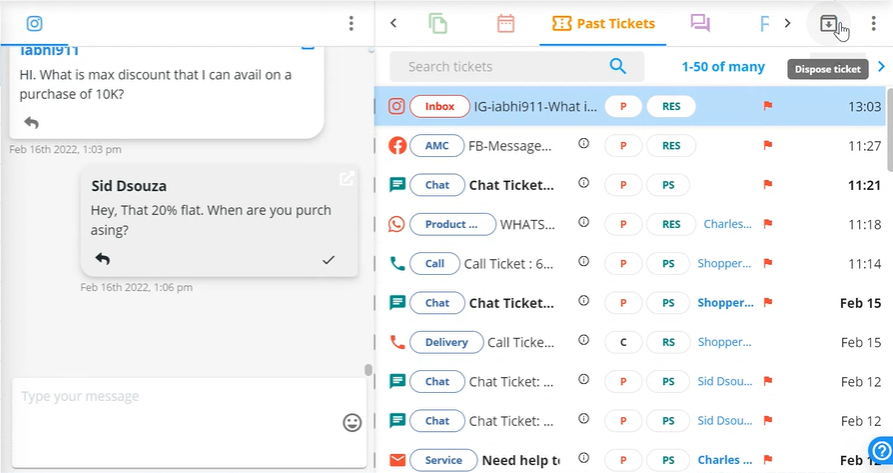Customers make or break your business. Hence, it is important to plant customers at the center of everything you do. This is exactly what it means to exist as a customer-centric company.
Setting off as a customer-centric company means incorporating a business culture that primarily focuses on providing a positive customer experience.
Importance of making your business customer-centric
There is nothing more important to a business than profit. It is the happy customers that propel your business towards profit. With a customer-centric approach, it is easy to retain and acquire customers.
An add-on benefit is that customer-centric companies make more profit than their product-centric counterparts.
The following Deloitte report agrees with the importance of being customer-centric to succeed and reap profits.
Customer-centric companies are 60% more profitable compared to companies not focused on customers.
Achieving customer-centricity is not as simple as it may sound. The baggage is bigger as it calls for an organizational shift towards commitment and technology for satisfying customer needs.
But you can get there by implementing proven and guaranteed strategies for building a customer-centric company. Also, find the best practices mentioned alongside.
1. Create a business-centric culture
Develop a culture centered around customer needs, aspirations, and values. It does not only mean presenting customer-value quotes on slides during the staff meetings, collecting customer feedback, and sending away the perfect thank you mail.
It indispensably means putting customer-centricity as a core value of the mission and vision statement of the organization. As well as, administering the customer-centric values into every single effort concerning your business.
Best practice:
- Employees do not operate customer-centrically overnight by going through the mission and vision statement in a memo.
- Introduce customer-centric values through strategic training programs to get employees’ acceptance and willingness.
- Also, empower employees to make customer-centric decisions.
- Hire the right employees that behold the core values of the organization.
- Reward employees with a track record of great customer service.
2. Carry out extensive market research to understand customers
Market research helps identify the customer’s attitude in regard to the product, service, pricing, or any other business facet.
Best Practice:
- As customers prefer to be heard digitally, investigate social media posts and online behavior to understand the buyer persona. This helps you understand the preferences and challenges of your target customer base in real-time.
- Customer relationship management software that integrates with multiple social media platforms can help monitor social media posts while being logged into a single platform.
- Customer relationship management software assists with market research by providing insights about the target audience, competitors, conversations around your product over social media, and so on.
3. Map the customer journey
Map the customer journey to visualize customer experience and to understand their needs at all touchpoints. With the insights obtained from the customer journey, you exactly know what it takes to ensure a smooth journey and hence better customer retention.
Best Practice:
Sales automation tools facilitate visualization of customer journey mapping through sales funnel charts viewed in its dashboard.
4. Collect and Manage customer data intelligently
Data is an important asset that takes your organization to the path of customer-centricity. Customer data can be collected through interviews, surveys, and online research.
With the right data being present, know how to use customer data optimally to benefit your customers.
Best Practice:
- Send automated survey forms to collect the feedback with Customer Data Management software and maintain customer profiles and history as well.
- The data management software backed by Artificial Intelligence has the potential to use customer data to maximize profits, all the while adhering to customer-centric principles.
5. Empower your employees to serve customers better
Let every undertaking of your employees reflect two things- how it benefits my customer and how can I make it better. If well-defined answers are not obtained, redo the task or rethink the decision.
Best Practice:
- Provide the support staff with best-in-class technology to deliver a superior customer experience. Customer service automation tools can automate a lot of repetitive tasks and can help offer faster solutions.
- It streamlines business workflows to make your organization more efficient in being customer-centric.
- A technology-backed intelligent agent can be made to assist your support staff. This agent offers contextual support that goes above and beyond the conventional path of customer support. Explore Kapture to know more about this.
6. Create customer-winning market strategies
The market strategies should appeal to the customers and be attuned to the customer-centric vision. For this, you must know
- Which customer base to target
- Pain areas of customers
- Right channel to connect to customers
Best Practice:
Customer Profiling software can help identify the best prospects in the target market using segmentation. It enables you to send personalized messages with adjustments in price for promotional offers. This way you can appeal to each segment’s interest and requirements when they look for a solution.
7. Make operational decisions with customers at the forefront
Every decision you make about your business, be it about mainstream issues or substantial matters, must be taken with customer interest in mind. So, hinge your decisions on customer intelligence.
Best practice:
- Customer intelligence tools help you gain a holistic understanding of customers through collecting, contextualizing, and analyzing data.
- It is possible to leverage data from multiple sources and analyze it in real-time.
For example,
You can learn that a 40-year-old man working in an executive job profile has moved to a certain locality with his large family.
When he looks out for low-priced items, the recommendation system of your customer intelligence tool offers coupons or other budget-friendly items.
The tool has guided you towards opportunities that take your business one step closer to the customer. And you just implemented a noteworthy strategy to become customer-centric.
8. Get customer-centric metrics
Customer-centric metrics tell you where your business is in accordance with the customer-centric approach. So make sure to find appropriate customer-centric metrics for the measurement.
Best practice:
Here are five customer-focused performance indicators or metrics important to a customer-centric organization,
- Customer lifetime value ( CLV)- It measures the income expected from a customer during the period of relationship with your company.
- Net promoter score (NPS)- It is an indicator of the referral counts.
- Customer retention rate- This metric measures the number of customers retained during a period.
- Customer satisfaction survey – This rating shows how satisfied are your customers with your products or services.
- First response time– It is the average amount of time taken by the staff to provide the first response to a customer query or support ticket. Customer help desk software can help achieve optimal response time with the incredible amount of automation it offers on your service workflows.
9. Open multiple channels for communication
Open up ways for the customer to communicate through different channels like chat, social media, or calls. Easy accessibility of communication channels can help build a sense of closeness with your organization.
Best practice:
- Customer relationship management software with omnichannel integration offers seamless conversations across several channels.
- To top it all, the service staff can reply while being logged into a single platform, and resolve the queries at the earliest yielding better first call resolution time (FCT).
10. Deliver personalized service
Your organization may be a pioneer in delivering exceptional service but is it personalized enough for the customer to feel connected with you?
Personalization is the key way to demonstrate intimacy towards customers. It drives better customer outcomes because customers expect organizations to deliver personalized interactions and services.
According to The State of Personalization reports 2021,
More than half (60%) of consumers can likely become repeat buyers after a personalized shopping experience with a retailer, up from 44% in 2017.
Best practice:
- Again, customer profiling software combined with analytics and artificial intelligence can recommend personalized solutions to customer queries.
- Also, predictive analytics algorithms in the background can judge what content and message should serve which customer.
- To further enhance your personalization agenda, send out personalized emails targeting specific customer segments based on any demographics.
11. Adopt a Design Thinking approach to problem-solving
Design thinking is the futuristic way to satisfy customers’ demands and solve customers’ problems. Here is what it means, explained through a scenario.
- A particular section of your business encountered a problem.
- Ideally, the first motive of your team is to solve the problem.
- With design thinking in place, it must be questioned how the problem originated in the first place to help develop a worthwhile solution.
Best practice:
Design thinking is perfectly done with productive brainstorming sessions centered around offering the best solutions to customers.
Evolve into a Customer-Centric Organization with Kapture,
a service automation platform that harnesses best-in-class technology to:
- Provide digitally-enabled interaction channels for both customers and staff.
- Avail customer data securely for implementing customer-centric strategies.
Manage healthy customer relations through automation of service touchpoints. Just so that you can lay the foundation for a customer-centric organization and move on towards profitable growth. Try a free demo to learn more.
About the Author | |
 | Seema C Mohan |
| Seema C Mohan is a content writer at Kapture. She is passionate about all things XaaS and loves to write value-added content. She has been in Business Process Management in the past and has experience in streamlining processes for Enterprise Mapping Projects. She has published technology articles in National and International journals. Her job at Kapture helps her gain more insight into the SaaS industry and emerging technologies. | |
,
,
,
,
,
,
,
,
,
,
,
,
,









